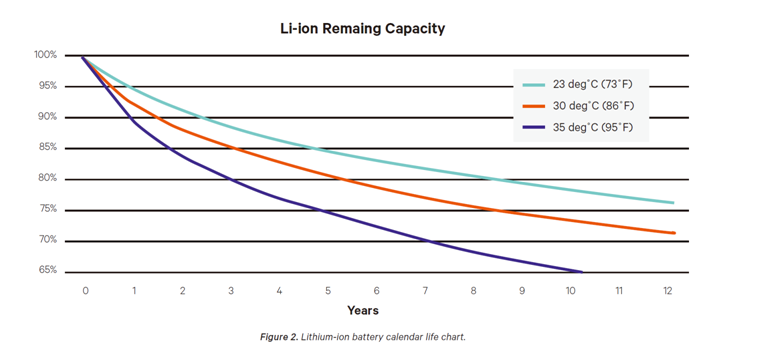One of the key attractions for moving to lithium batteries is the battery life being multiples of what is possible with lead-acid batteries. Yet, with limited operating data in UPS applications available today, it’s natural for potential users to question how long lithium batteries will actually last.
To address this question, it’s necessary to first understand how lithium battery packs degrade under normal circumstances. They have two largely independent modes of degradation: calendar life and cycle life.
Calendar life describes how the capacity will decline and how the resistance will increase over time. For calendar life, the operating temperature of the battery is the most important factor in determining how long it will last. Heat can accelerate degradation and cooler temperatures minimize degradation.
As for cycle life, the term itself is easily understood but projecting cycle life of a lithium cell is not as simple as it would seem. This is because different characteristics of the cycle determine how damaging that cycle is to the battery.
A baseline test in the lithium industry is to fully discharge the battery in one hour and then recharge it fully in one hour at room temperature (25°C / 77°F). For high-quality cell designs, this is an easy test that will result in thousands of cycles before the cell reaches 80% of its initial capacity. However, cycle life is typically quite sensitive to the charge and discharge rates and other factors.
A summary of the key factors that influence cycle life is shown in Figure 1.
|
Cycle Parameter |
Influence on Cycle Life |
Description |
|
Charge / Discharge Rate |
Significant |
Charging or discharging a battery at rates higher than it was designed for will shorten its cycle life considerably |
|
Depth of Discharge |
Moderate |
Partially discharging a battery before recharging is less damaging than discharging it completely |
|
Temperature |
Moderate |
While a warmer battery will have less resistance and lower self-heating rates, cooler operating temps are generally better for life. Many lithium-ion batteries are also sensitive to charging at cold temps (usually below freezing) but this is generally not a concern for data center applications |
|
State of Charge (SOC) Window |
Minor |
When using a battery at partial depth of discharge, cycling it near completely full (100% SOC) or completely empty (0% SOC) is more damaging than specifying an operating window at partial states of charge |
Figure 1: Summary of the key factors that influence lithium battery cycle life.
In data center applications, calendar life is typically the primary driver because battery cycling is infrequent. The exception to this would be when UPS batteries are being used to support site energy management or providing grid services to the local electricity distribution network. Those applications are outside the scope of this paper. In conventional use cases, the batteries are idle for most of their operating life.
To assess calendar life, cell manufacturers typically store batteries at different temperatures for long periods of time and periodically check their remaining capacity. Charting this data provides a relationship between time, temperature and remaining capacity. After enough data has been collected, it’s possible to fit the data to a generally accepted equation for calendar life which has been proven over decades of lithium-ion battery field experience. An example of a lithium battery (NCM) calendar life chart is shown in Figure 2.

Figure 2 shows that 80% of initial capacity of a NCM battery remains after about ten years at temperatures of 23°C (73°F) for the particular lithium battery tested. Different lithium batteries like Lithium iron phosphate will have different rates of degradation.
To provide you a battery with long cycle life, uninterrupted discharging performance, fast charging capability, high energy density, and to give you worry free operation, EverExceed offers you Lithium Iron Phosphate (LFP) technology batteries which provides 3000-5000+ life cycles based on your application requirements.
For any inquiry, welcome to contact us at marketing@everexceed.com
categories
recent posts
scan to wechat:everexceed
